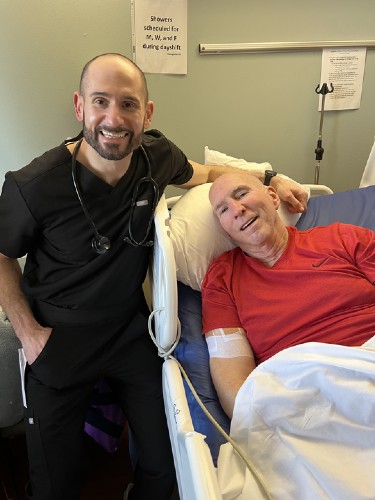 For 40 years, John Eidman’s mornings followed a steady rhythm: wake up at 5 a.m., get in a workout, make a healthy breakfast and head off to work in oil and gas management.
For 40 years, John Eidman’s mornings followed a steady rhythm: wake up at 5 a.m., get in a workout, make a healthy breakfast and head off to work in oil and gas management.
Today, the now 71-year-old’s mornings follow a new kind of routine. Three days a week, he and his wife Nadine spend three focused hours at TIRR Memorial Hermann Outpatient Rehabilitation – Kirby Glen Center, moving through a carefully planned schedule of occupational, speech and physical therapy.
That change began after John experienced a life-altering stroke on December 7, 2023. While his days may not look the way they once did, John and Nadine remain optimistic—grateful for their progress, their time with family and the care team they credit with giving them a second chance.
“We wouldn’t be where we are today without Dr. Falco, Dr. Ivanhoe and the rehabilitation team at TIRR Memorial Hermann,” Nadine said. “They didn’t just help John recover—they helped both of us prepare for life at home and gave us the support we needed to rebuild our life.”
A Morning Like Any Other
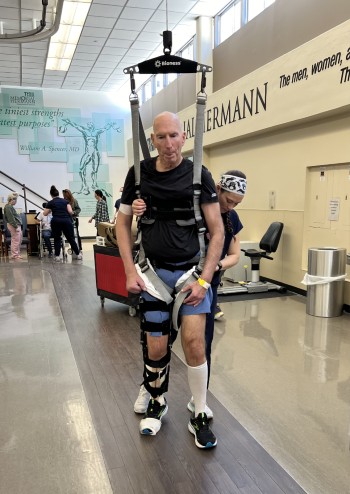 It started with something subtle: John was pointing at the television, trying to speak, but his words came out jumbled and incoherent. When Nadine found him in the bathroom moments later, his face was drooping on one side. She immediately called 911.
It started with something subtle: John was pointing at the television, trying to speak, but his words came out jumbled and incoherent. When Nadine found him in the bathroom moments later, his face was drooping on one side. She immediately called 911.
Paramedics rushed John to the Emergency Center at Red Duke Trauma Institute at Memorial Hermann-Texas Medical Center, one of only two Level I trauma centers in the Greater Houston area. A CT scan in the Mobile Stroke Unit confirmed the diagnosis: a severe left-brain hemorrhagic stroke.
A hemorrhagic stroke occurs when a weakened blood vessel in the brain bursts, causing blood to leak into surrounding brain tissue. While ischemic strokes—caused by blood clots blocking blood flow—are more common, both types of stroke are medical emergencies that require rapid diagnosis and immediate, highly specialized care. Advanced imaging techniques like CT and MRI help providers quickly determine the type and extent of stroke so treatment can begin without delay.
John had been on blood thinners to help prevent a clot-related stroke due to atrial fibrillation, a condition where the heart beats irregularly and increases the risk of stroke. But his stroke turned out to be the less common type. At first, it was unclear how much he would recover.
John underwent emergency surgery; his stroke was so serious that his family feared the outcome might not change, even with intervention. After surgery, he spent 10 days in the Neuro ICU in critical condition at Memorial Hermann-Texas Medical Center. He remained hospitalized through the holidays and was discharged on December 30 to a skilled nursing facility to continue his recovery. From there, he and Nadine prepared for the next phase of his healing journey: inpatient rehabilitation at TIRR Memorial Hermann in the Texas Medical Center. TIRR Memorial Hermann is a national leader in medical rehabilitation and research, and is consistently ranked among America's Best Hospitals by U.S. News & World Report.
The Therapy Team That Makes All the Difference
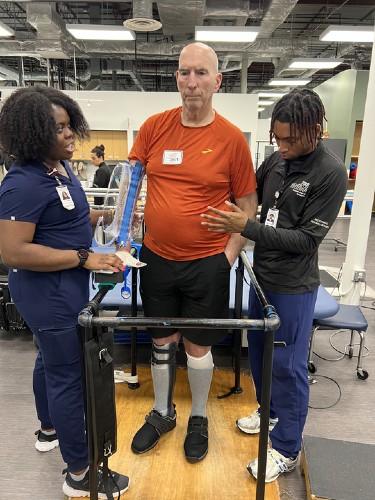 John and Nadine spent the next five weeks focused entirely on John’s recovery. Nadine joined every therapy session, learned from the team and began preparing their home for what life would require next—from mobility aids and home modifications to transportation and wound care.
John and Nadine spent the next five weeks focused entirely on John’s recovery. Nadine joined every therapy session, learned from the team and began preparing their home for what life would require next—from mobility aids and home modifications to transportation and wound care.
As John transitioned from inpatient to outpatient care, he continued working with a skilled team of therapists who have supported him across different phases of recovery. That includes Charlene, Leticia, Josh and Genevieve—along with his current core team: occupational therapist Moriah G., speech therapist Madeline J. and physical therapists Hannah T. and Kelley P. Together, they’ve built a personalized, integrated care plan, an approach that’s central to how the Stroke Rehabilitation Program at TIRR Memorial Hermann supports patients with complex neurological injuries.
“Recovery after a severe stroke is highly individualized,” said Christopher Falco, MD, physical medicine and rehabilitation physician, and Chief of Staff, TIRR Memorial Hermann. “Our goal is to assess each patient’s specific neurological deficits and functional potential, then implement an interdisciplinary care plan that promotes meaningful improvements in quality of life. For John and others with complex injuries, rehabilitation is where the real work of regaining function and independence takes place.”
John's Weekly Therapy Schedule
Three days a week. Three hours a day. Three paths to healing.
9 a.m. – Moriah focuses on occupational therapy, helping John regain independence in daily activities like getting dressed, managing hygiene and eating meals. Her sessions build fine motor skills and upper body strength, using adaptive strategies that carry over into everyday routines at home.
10 a.m. – Madeline leads speech therapy, supporting John’s communication and cognition that were severely impacted from his stroke. She tailors each session to improve not only speech but also comprehension, memory and safe swallowing, testing John to determine when to remove the feeding tube that was placed while in the ICU. Whether she’s strengthening the muscles used in speech or helping John manage aphasia—a language disorder that affects his ability to find or form words—her work helps restore connection and confidence.
11 a.m.- Hannah and Kelley guide John through physical therapy, working to rebuild his strength, balance and mobility through personalized exercises and specialized equipment. From transfers to walking, every movement is designed to safely expand what John can do on his own.
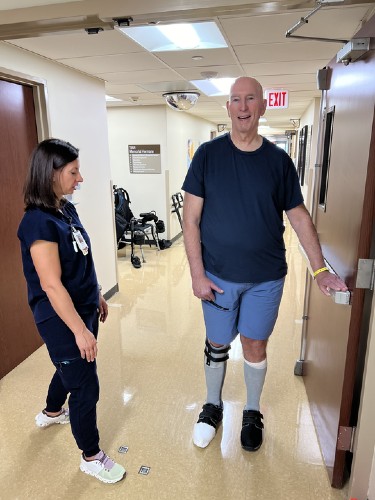 Also involved in John’s care is Cindy Ivanhoe, MD, director of the spasticity program at the TIRR Memorial Hermann Outpatient Medical Clinic, who focuses on managing tone, spasticity and other challenges that can follow a stroke—support that has been essential during both inpatient and outpatient phases of John’s recovery. “They all work together so seamlessly,” Nadine said. “They communicate constantly, adjust as he progresses and never once back down from a challenge. They’re creative, encouraging and totally focused on helping John get better.”
Also involved in John’s care is Cindy Ivanhoe, MD, director of the spasticity program at the TIRR Memorial Hermann Outpatient Medical Clinic, who focuses on managing tone, spasticity and other challenges that can follow a stroke—support that has been essential during both inpatient and outpatient phases of John’s recovery. “They all work together so seamlessly,” Nadine said. “They communicate constantly, adjust as he progresses and never once back down from a challenge. They’re creative, encouraging and totally focused on helping John get better.”
That collaboration extends well beyond the therapy room. The team has helped the Eidmans secure a customized power wheelchair and other specialty equipment. They’ve also guided Nadine through every detail of wound care and home setup and taught her safe techniques to care for John so she could feel confident doing it on her own.
With the help of his therapists and advanced tools for supported walking and gait training, John’s recovery continues to gain momentum. Nadine says his drive and determination often lead them to sign up for extra activities, like locomotor training with Kelley or pickleball on Sundays—motivation the team is always ready to meet.
Today, John continues his recovery alongside the same trusted team, building on every breakthrough, one session at a time.
Continuing the Journey Together
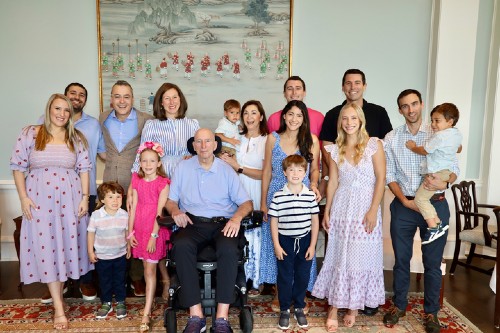 Just 15 months after the stroke, John and Nadine are learning how to thrive in a new way. While John is unlikely to regain full independence and his ability to verbalize is limited, they are grateful for the tremendous progress he’s made at TIRR Memorial Hermann. They find joy in church and in time with their grandchildren, recently welcoming their sixth in January 2025, and they’re excited to celebrate their oldest son’s wedding next year. John is as determined as ever—smiling, joyful, responsive and giving it his all, just like he did during his morning workouts for 40 straight years.
Just 15 months after the stroke, John and Nadine are learning how to thrive in a new way. While John is unlikely to regain full independence and his ability to verbalize is limited, they are grateful for the tremendous progress he’s made at TIRR Memorial Hermann. They find joy in church and in time with their grandchildren, recently welcoming their sixth in January 2025, and they’re excited to celebrate their oldest son’s wedding next year. John is as determined as ever—smiling, joyful, responsive and giving it his all, just like he did during his morning workouts for 40 straight years.
“John still feeds off our energy,” Nadine says. “When you’re a caregiver, you have to be positive, even when you’re exhausted. You’re sleeping on a chair, eating frozen meals and managing a dozen things. But you hold onto hope. And if you’re lucky enough to have a team like we did at TIRR Memorial Hermann, that hope becomes real.”
She encourages other families beginning the stroke recovery journey to see it as a marathon, both physically and emotionally. Leaning on the care team, staying curious and trusting the process, she says, can make all the difference. And sometimes, the progress can feel nothing short of remarkable.
John’s story is one of partnership, persistence and recovery made possible by a team that never gave up and a family that never stopped showing up.
To learn more about the TIRR Memorial Hermann Stroke Rehabilitation Program »
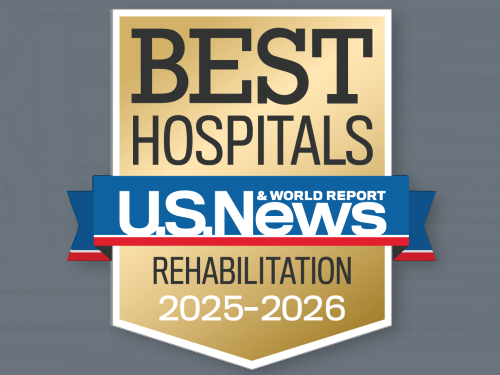
Nationally Ranked Rehabilitation
For the 36th consecutive year, TIRR Memorial Hermann is recognized as the best rehabilitation hospital in Texas and No. 2 in the nation according to U.S. News and World Report's "Best Rehabilitation Hospitals" in America.
Learn more about TIRR Memorial Hermann rankingsContact Us
If you have questions or are looking for more information, please complete the form below and we will contact you.